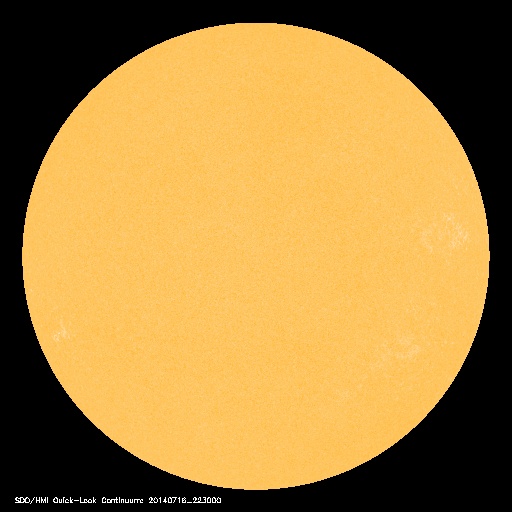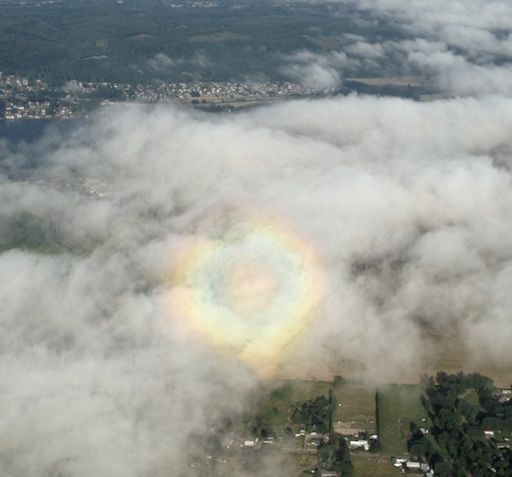When is the best time to see auroras? Where is the best place to go? And how do you photograph them? These questions and more are answered in a new book, Northern Lights - a Guide, by Pal Brekke & Fredrik Broms. | | | THREE WEEKS TO COMET 67P: The European Space Agency's Rosetta probe is now less than 10,000 km from its target: 67P/Churyumov-Gerasimenko. Rosetta is expected to reach and begin orbiting the comet's nucleus on August 6th. Long-range images suggest that the comet is a contact binary. This could present some interesting challenges for Philae, the probe's lander, which is slated to touch down on the comet's surface in early November. Check the Rosetta home page for updates. WHERE DID ALL THE SUNSPOTS GO? This week, solar activity has sharply declined. There are only two numbered sunpots on the Earth-facing side of the sun, and each is so small you might have trouble finding them. Click to enlarge this July 17th image from NASA's Solar Dynamics Obervatory and see if you can locate AR2113 and AR2114: 
In case you couldn't find them, here they are. Long-time readers absorbing this image might be reminded of 2008-2009, years when the sun plunged into the deepest solar minimum in a century. The resemblance, however, is only superficial. Researchers believe that, underneath the visible surface of the sun, the solar dynamo is still churning out knots of magnetism that will soon bob to the surface to make sunspots. Solar Max is not finished. For the moment, though, it seems to have paused. Solar activity is very low, and NOAA forecasters put the daily odds of an X-class flare no more than 1%. Updates on Twitter @spaceweatherman. Realtime Space Weather Photo Gallery HEART-SHAPED CLOUD PHENOMENON: Frequent fliers who look out the window of their planes often see the shadow of the aircraft dipping in and out of clouds below. The interplay of light and shadow with water droplets in the clouds can produce colorful rings of light called "glories." On July 13th, Tony DeFreece saw a glory that was not a colorful ring, but rather a heart: 
"I was flying over Oregon when I looked out and saw this heart-shaped figure," he says. "It was one of those moments when the Universe aligns and takes your breath away." DeFreece suspects, probably correctly, that the shape of the clouds bent the usual circular glory into the heart-shaped apparition. Mystery solved? Not entirely. Glories are caused by sunlight reflected backwards from water droplets in clouds. Exactly how backscattering produces the colorful rings, however, is a mystery involving surface waves and multiple reflections within individual droplets. Each sighting is a lovely puzzle, so grab the window seat and keep an eye on the clouds below.
Realtime NLC Photo Gallery
Realtime Comet Photo Gallery
Realtime Aurora Photo Gallery
Every night, a network of NASA all-sky cameras scans the skies above the United States for meteoritic fireballs. Automated software maintained by NASA's Meteoroid Environment Office calculates their orbits, velocity, penetration depth in Earth's atmosphere and many other characteristics. Daily results are presented here on Spaceweather.com. On Jul. 16, 2014, the network reported 37 fireballs.
( 37 sporadics)  In this diagram of the inner solar system, all of the fireball orbits intersect at a single point--Earth. The orbits are color-coded by velocity, from slow (red) to fast (blue). [Larger image] [movies] Potentially Hazardous Asteroids ( PHAs) are space rocks larger than approximately 100m that can come closer to Earth than 0.05 AU. None of the known PHAs is on a collision course with our planet, although astronomers are finding new ones all the time. On July 16, 2014 there were 1490 potentially hazardous asteroids. Notes: LD means "Lunar Distance." 1 LD = 384,401 km, the distance between Earth and the Moon. 1 LD also equals 0.00256 AU. MAG is the visual magnitude of the asteroid on the date of closest approach. | | The official U.S. government space weather bureau | | | The first place to look for information about sundogs, pillars, rainbows and related phenomena. | | | Researchers call it a "Hubble for the sun." SDO is the most advanced solar observatory ever. | | | 3D views of the sun from NASA's Solar and Terrestrial Relations Observatory | | | Realtime and archival images of the Sun from SOHO. | | | from the NOAA Space Environment Center | | | the underlying science of space weather | | 
